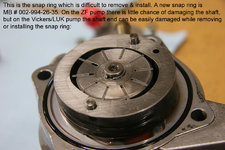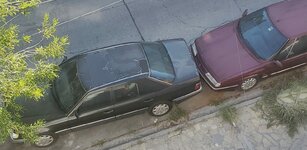Navigation
Install the app
How to install the app on iOS
Follow along with the video below to see how to install our site as a web app on your home screen.
Note: This feature may not be available in some browsers.
More options
Style variation
-
Hi Guest !
Welcome to the 500Eboard forum.
Since its founding in late 2008, 500Eboard has become the leading resource on the Internet for all things related to the Mercedes-Benz 500E and E500. In recent years, we have also expanded to include the 400E and E420 models, which are directly related to the 500E/E500.
We invite you to browse and take advantage of the information and resources here on the site. If you find helpful information, please register for full membership, and you'll find even more resources available. Feel free to ask questions, and make liberal use of the "Search" function to find answers.
We hope you will become an active contributor to the community!
Sincerely,
500Eboard Management
You are using an out of date browser. It may not display this or other websites correctly.
You should upgrade or use an alternative browser.
You should upgrade or use an alternative browser.
HOW-TO: Removing and re-sealing ZF tandem pump (SLS and power steering)
- Thread starter gerryvz
- Start date
When cutting that little rubber hose to length is there suppose to be an angle cut on the one end ?
No. I did add a few extra mms to the stock hose length, for good measure.
Re: Transmission problem -- VERY reluctant to upshift
Doug, did you replace the camshaft seal on the driver's side? I'm in the process of changing the ignition components and I noticed an oil leak at the cam seal which I think may have been causing my rough idle/slight misfire issue. I'm picking up new seals from MB today. Hoping his won't be one of those persistent cam seal leaks due to camshaft surface or something else. Also, did you seal or replace both of the cam solenoids? The passenger side solenoid has oil residue all over the connector and surrounding areas. Thanks.
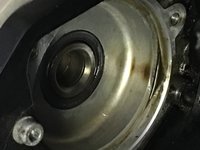

+1 on this advice. I did remove and reseal the cam advance solenoid as well as the cam lip seal behind the distributor.
I used the MB black sealant instead of the MB (Loctite 574) orange sealant on the solenoid. so far so good.
Doug, did you replace the camshaft seal on the driver's side? I'm in the process of changing the ignition components and I noticed an oil leak at the cam seal which I think may have been causing my rough idle/slight misfire issue. I'm picking up new seals from MB today. Hoping his won't be one of those persistent cam seal leaks due to camshaft surface or something else. Also, did you seal or replace both of the cam solenoids? The passenger side solenoid has oil residue all over the connector and surrounding areas. Thanks.


Re: Transmission problem -- VERY reluctant to upshift

The solenoid can leak from the connector area... you can try to add external sealant where the square plastic pops out of the metal housing, otherwise you'd have to either replace them, or do a rebuild as seen in this thread.Doug, did you replace the camshaft seal on the driver's side? I'm in the process of changing the ignition components and I noticed an oil leak at the cam seal which I think may have been causing my rough idle/slight misfire issue. I'm picking up new seals from MB today. Hoping his won't be one of those persistent cam seal leaks due to camshaft surface or something else. Also, did you seal or replace both of the cam solenoids? The passenger side solenoid has oil residue all over the connector and surrounding areas. Thanks.

Re: Transmission problem -- VERY reluctant to upshift
I did see that thread Dave. Thanks. I will probably buy a new one soon.
The solenoid can leak from the connector area... you can try to add external sealant where the square plastic pops out of the metal housing, otherwise you'd have to either replace them, or do a rebuild as seen in this thread.

I did see that thread Dave. Thanks. I will probably buy a new one soon.
Re: Transmission problem -- VERY reluctant to upshift

If you buy new... make sure to get the right ones. There are 2 different types. The 500E uses the early / expensive solenoids. You can use the late/cheaper ones if you also replace the armature (round thingy that bolts to the center cam adjuster).I did see that thread Dave. Thanks. I will probably buy a new one soon.

Re: Transmission problem -- VERY reluctant to upshift
If the original ones are better than I'll probably just buy an original. What is the correct PN? Price? Thanks
If you buy new... make sure to get the right ones. There are 2 different types. The 500E uses the early / expensive solenoids. You can use the late/cheaper ones if you also replace the armature (round thingy that bolts to the center cam adjuster).

If the original ones are better than I'll probably just buy an original. What is the correct PN? Price? Thanks
Re: Transmission problem -- VERY reluctant to upshift
The original is PN 104-050-01-77, however it appears this is NLA and has been replaced / superceded to the new style (119-051-01-77), $107 list / $80 Naperville. The old/early version isn't necessarily better.
If you buy the new style (119-051-01-77) you also must replace the armature (111-051-00-43) at the same time, also replacing the stretch bolt (104-990-10-04).
More details in the FSM here:
http://www.w124-zone.com/downloads/MB CD/W124/w124CD1/Program/Engine/119/05-2175.pdf
If the original ones are better than I'll probably just buy an original. What is the correct PN? Price? Thanks
The original is PN 104-050-01-77, however it appears this is NLA and has been replaced / superceded to the new style (119-051-01-77), $107 list / $80 Naperville. The old/early version isn't necessarily better.
If you buy the new style (119-051-01-77) you also must replace the armature (111-051-00-43) at the same time, also replacing the stretch bolt (104-990-10-04).
More details in the FSM here:
http://www.w124-zone.com/downloads/MB CD/W124/w124CD1/Program/Engine/119/05-2175.pdf
They are interchangeable, but you will need a slightly longer hose between the reservoir and pump for the LuK/Vickers pump.I have a ZF pump and need to replace it. Can I use a LuK pump or does it have to ZF ?

The standard (non-tandem) pump procedure is just the rear part of the tandem pump, so it's pretty similar. The FSM procedure covers this very well. Usually the failure is the front shaft seal, which causes a leak, but you have to take apart most of the pump to change it. On the bright side, for the non-tandem pump, you can leave the pump on the car and just remove the front portion & replace the main seal... leaving the rear section bolted to the bracket. Saves a lot of time.


I can't see where the leak is. Replaced the rubber hose from the reservoir but the bottom of the pump is VERY wet and dripping onto the top of the A/C compressor. I did remove the front pulley but can't see anything really wet there.
What other location could be leaking?
What other location could be leaking?
If it's the front seal, it will be very obvious with the pulley removed (and, the back side of the pulley will be full of PS fluid & dirt). If everything is dry at the front shaft seal, you need to keep looking. Are you certain it is a PS fluid leak, i.e. is the PS fluid level dropping in the reservoir? An engine oil leak from the cam solenoid area (or, valve cover corner) would also drop on the A/C compressor. It would be unusual to have a ZF standard pump leaking from anywhere besides the front seal.I can't see where the leak is. Replaced the rubber hose from the reservoir but the bottom of the pump is VERY wet and dripping onto the top of the A/C compressor. I did remove the front pulley but can't see anything really wet there.
What other location could be leaking?

Re: HOW TO: Removing and re-sealing ZF tandem pump (SLS and power steering)
Do you have the torque spec. for the nipple pipe that the hose attaches to. The one that screws through the bottom of the reservoir housing and uses an aluminum crush washer?Be careful with extra-length hoses, there is precious little room for extra hose length. The EPC specifies the correct lengths needed, which are different for ZF and Vickers/LuK pumps.

Re: HOW TO: Removing and re-sealing ZF tandem pump (SLS and power steering)
http://www.w124performance.com/docs/mb/M119/M119_power_steering_hose_TSB.pdf
However, the posted spec of 6Nm seems ridiculously low for such a large thread, and I suspect it's a typo.

It's in the TSB at this link:Do you have the torque spec. for the nipple pipe that the hose attaches to. The one that screws through the bottom of the reservoir housing and uses an aluminum crush washer?
http://www.w124performance.com/docs/mb/M119/M119_power_steering_hose_TSB.pdf
However, the posted spec of 6Nm seems ridiculously low for such a large thread, and I suspect it's a typo.

Great document...thanks...and yes, that does seem low.
I just replaced the hose with new clamps and reservoir gasket and it is still leaking under there. Hard to tell exactly where with a flashlight and mirror, but it looks like that pipe is leaking. I'll take it all apart again and look for damage to the threads or casting.
Do you know the correct length for the rubber pipe? ZF pump.
I'll cut a new one.... gawd knows I have enough pipe!! :?
I just replaced the hose with new clamps and reservoir gasket and it is still leaking under there. Hard to tell exactly where with a flashlight and mirror, but it looks like that pipe is leaking. I'll take it all apart again and look for damage to the threads or casting.
Do you know the correct length for the rubber pipe? ZF pump.
I'll cut a new one.... gawd knows I have enough pipe!! :?
See post #198.Do you know the correct length for the rubber pipe? ZF pump. I'll cut a new one.... gawd knows I have enough pipe!! :?

What PS fluid are you using in the ZF pump in the 400E? Can we use any "off the shelf" PS fluid ?
Best to use the OE fluid from MB, its not expensive.
Dexron II/III ATF was allowed, but not recommended. The OE fluid is preferred and at under $10 per bottle, it's not worth dinking with ATF. Also, the OE fluid is gold-colored, which makes it easier to tell which fluid is leaking if you have a leak down under. With ATF in the PS system, sometimes you can't tell the difference between a PS leak and a leak from one of the trans cooler hoses.Thanks, but wasn't transmission fluid spec. for the early 90's cars?

Attachments
On the .034 (without SLS), yes, a couple of times.anyone only rebuilt the front of the pump without removing it?
thanks
Pretty sure you could do the same with the tandem pump, but if you need to replace any of the hoses, it would make more sense to remove the pump and fix everything right the first time.

After reading through this thread to identify parts I need for a tandem pump reseal I am not convinced I need the rebuild. My leak is in power steering fluid. And I am taking special note of this comment from Gerry.
I need to do a careful diagnosis. I may need to simply address reservoir hose only again. Or try and clean up the area and note where the leak is. I am pretty sure I am NOT losing SLS fluid.
Note -- a month or two after you install the short hose, make sure that you re-tighten it as the clamps compress the hose a bit. After a while the compression can cause it to leak/weep a bit, so snugging it down after a period is a good prudent thing to do.
I need to do a careful diagnosis. I may need to simply address reservoir hose only again. Or try and clean up the area and note where the leak is. I am pretty sure I am NOT losing SLS fluid.
Ricardo, if you confirm are losing PS fluid and not SLS fluid... the pump may be fine.
Best starting point is cleaning up the pump and surrounding area so it's all dry, and pinpointing the leak source. Anywhere behind and out of the way of the pulley, you can stuff paper towels to help locate the leak.

Best starting point is cleaning up the pump and surrounding area so it's all dry, and pinpointing the leak source. Anywhere behind and out of the way of the pulley, you can stuff paper towels to help locate the leak.

Just to close this out. The pump was fine. I just needed to go in and redo the reservoir short hose and update the clamps. So everyone should spend the time to identify the type of fluid leak (PS fluid) and start with the cheaper repair first like I did.
I do now have a rebuild kit in reserve. Here is a photo of the rebuild seal kits for the ZF Pump. 000 460 37 80
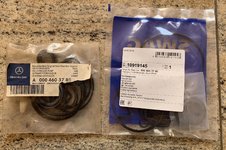
I do now have a rebuild kit in reserve. Here is a photo of the rebuild seal kits for the ZF Pump. 000 460 37 80

Re: Power Steering Pump Leak Investigation
Yes, exactly. They used both ZF and Vickers/LuK tandem pumps. The Vickers/LuK pumps are a bit more of a PITA in a couple of ways - there is an extra circlip in the system (from what I understand) and (according to GSXR) the small lip at the end of the shaft that the main circlip attaches to, is quite brittle and can be easily damaged when removing or installing the clip. The ZF pump's flange/lip seems to be of a more robust design.
MB offers two different rebuild kits as well - one for each brand of tandem pump.
Cheers,
Gerry
I used your write/pictures up to assist me in my 1990 R129 Vickers rebuild as it was much was similar. Thank you. I have included some pump rebuild instructions with diagrams and torque values. My recommendation is not to remove the pump , but to remove the 3 bolts and remove the housing that the pump is attached to. My reasoning is that 2 of the bolts are accessible from the front of the vehicle and the 3rd is a bolt(not allen head which strip). The bolt is visible and more accessible using a deep 13mm socket with 1" extension. Break the bolt free with a breaker bar and then use an air ratchet($17 at HF) and the air ratchet was the key. Just push the button and done. The same for install. They have a cool electric one like the old milwaukee, but not in my budget just now.
The c clip on the pump shaft is easy to remove with the Lisle 44900 lock ring pliers($15 AMZN). The seal kit from MB was $88(benzpartshq.com) and had a new clip in it. Had to grind the edges of the pliers a bit to get inside the edges. As far as the lock ring inside the bore housing for the flow control valve in the steering part of the pump goes, its easy to get out for cleaning and inspection. But getting it back in was a challenge. The flow control valve has a screen on the back side that needs to be cleaned and particles flushed out. So its removal is necessary for inspection for scarring. The flow control valve is also spring loaded, so holding it in place to get the clip back in was the challenge. But Harbor Freight has a C clamp tool($3) that will hold it as the adjustable side of the clamp is rubber tipped and the depth will go into the pump housing. Pump the pump in a vise with the clamp and its doable.
As far as the seal rings go, getting the inner one out was the most difficult. I heated the pump housing in the oven to 200 deg. and used this cool tool, a blind inner bearing puller/remover/extractor by 8 Mile Lake($60 AMZN) They had just the right size made it a breeze. Keep the seals in the freezer and re-heat the pump housing and drive them in with some lube and deep sockets. A 17mm and a 19mm.
I have included some R&R MB pump rebuild instructions for a few different pumps. So for $187 in tools and parts vs $600 (return plus core shipping for a rebuild) let alone labor savings on the pump removal and install, its a deal.
I did switch out the Allen bolts holding the pump on the housing for 8.8 weight Hex bolts as I did strip 2 of them having been torqued in place for 30 years.
Oh and aas a note, make sure you put 2 copper seal rings on the banjo fitting when reattching the high side of the suspension pump line. My pump was leaking because someone had removed the line and not put the copper seals back correctly. In-fact check that first when you disassemble as that could be a source of your leak.
Also, try some AT-205 resealer as a stop gap to puff up the seals a bit, and it will also condition the seals on the struts!
Attachments
Last edited:
Thank you for the contribution and description of your experience and recommendations. Very helpful and appreciated !!I used your write/pictures up to assist me in my 1990 R129 Vickers rebuild as it was much was similar. Thank you. I have included some pump rebuild instructions with diagrams and torque values. My recommendation is not to remove the pump , but to remove the 3 bolts and remove the housing that the pump is attached to. My reasoning is that 2 of the bolts are accessible from the front of the vehicle and the 3rd is a bolt(not allen head which strip). The bolt is visible and more accessible using a deep 13mm socket with 1" extension. Break the bolt free with a breaker bar and then use an air ratchet($17 at HF) and the air ratchet was the key. Just push the button and done. The same for install. They have a cool electric one like the old milwaukee, but not in my budget just now.
The c clip on the pump shaft is easy to remove with the Lisle 44900 lock ring pliers($15 AMZN). The seal kit from MB was $88(benzpartshq.com) and had a new clip in it. Had to grind the edges of the pliers a bit to get inside the edges. As far as the lock ring inside the bore housing for the flow control valve in the steering part of the pump goes, its easy to get out for cleaning and inspection. But getting it back in was a challenge. The flow control valve has a screen on the back side that needs to be cleaned and particles flushed out. So its removal is necessary for inspection for scarring. The flow control valve is also spring loaded, so holding it in place to get the clip back in was the challenge. But Harbor Freight has a C clamp tool($3) that will hold it as the adjustable side of the clamp is rubber tipped and the depth will go into the pump housing. Pump the pump in a vise with the clamp and its doable.
As far as the seal rings go, getting the inner one out was the most difficult. I heated the pump housing in the oven to 200 deg. and used this cool tool, a blind inner bearing puller/remover/extractor by 8 Mile Lake($60 AMZN) They had just the right size made it a breeze. Keep the seals in the freezer and re-heat the pump housing and drive them in with some lube and deep sockets. A 17mm and a 19mm.
I have included some R&R MB pump rebuild instructions for a few different pumps. So for $187 in tools and parts vs $600 (return plus core shipping for a rebuild) let alone labor savings on the pump removal and install, its a deal.
I did switch out the Allen bolts holding the pump on the housing for 8.8 weight Hex bolts as I did strip 2 of them having been torqued in place for 30 years.
Oh and aas a note, make sure you put 2 copper seal rings on the banjo fitting when reattching the high side of the suspension pump line. My pump was leaking because someone had removed the line and not put the copper seals back correctly. In-fact check that first when you disassemble as that could be a source of your leak.
Also, try some AT-205 resealer as a stop gap to puff up the seals a bit, and it will also condition the seals on the struts!
I'll add my 2 cents as well. I just completed rebuild task, overall pretty easy if you have pump on the bench like I had  It come out pretty nice:
It come out pretty nice:

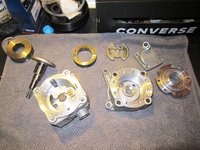
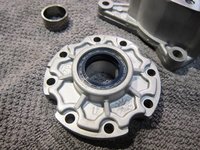
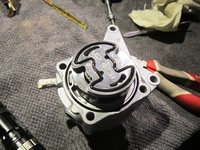

Now my tip: for some reason the 4 small pistons only came back into the same slots they came out of. It took me quite a while to figure out what goes where. I'm not sure if it's only my pump or all of them. Anyway, it might be a good idea to mark which one goes where during taking the pump apart.
Oh and the aftermarket rebuild kits are still available at eBay here - I have no affiliation with the seller, just post this link in case someone would like to buy one. Just be prepared for long waiting time, they are on backorder, it took 3 months to get my first kit and 2 for the second one for my spares stash. Here is the kit:

Just excuse me the dirty background...





Now my tip: for some reason the 4 small pistons only came back into the same slots they came out of. It took me quite a while to figure out what goes where. I'm not sure if it's only my pump or all of them. Anyway, it might be a good idea to mark which one goes where during taking the pump apart.
Oh and the aftermarket rebuild kits are still available at eBay here - I have no affiliation with the seller, just post this link in case someone would like to buy one. Just be prepared for long waiting time, they are on backorder, it took 3 months to get my first kit and 2 for the second one for my spares stash. Here is the kit:

Just excuse me the dirty background...
I am struggling with a ZF non tandem pump which is leaking somewhere I have it found. It definitely leaks worse when temperatures drop drying up when weather warms up 60 deg up. I replaced the front seal with a MB part. I replaced the short hose and new clamps and that is bone dry the top of pump is clean and dry. Both line connections are dry. Still the bottom of the pump has droplets of hydraulic fluid and the reservoir level drops over time. I checked the cam seals and they are clean and dry. So it is definitely hydraulic fluid. The inside of the front pulley is clean and dry. I have no indication of where this fluid is coming from unless the front half of the pump is leaking from the back half at the seam? Ideas?Re: Power Steering Pump Leak Investigation
I got the MB gasket too. Who'da thunk that a simple line of silicon around the edge of a round gasket would be worth $27! That's almost as expensive a fluid (by volume) as HP inkjet printer ink !!!
Have a nice German tubular hand pump to evacuate things, and can use a rubber hose on the end of my shop turkey baster to get down below the reservoir in the feed line. I think I will tackle the job this weekend. Thanks very much for the offer on the hose, but I already got a length (my car has a visceral reaction to non-MB and OEM parts, as evidenced by my transmission's puking with the Meyle tranny filter installed
Will definitely take your advice on the clamps too, and will document the job. Hopefully this solves it ... if not, then at least I have all the hoses and everything (except the ZF pump reseal kit) to do the rest of the job...
Cheers,
Gerry
Based on your description, it does sound like the leak is from the seam, or from one of the bolt holes? This assumes the top is completely dry and the hose/ports are all dry as well.I am struggling with a ZF non tandem pump which is leaking somewhere I have it found. It definitely leaks worse when temperatures drop drying up when weather warms up 60 deg up. I replaced the front seal with a MB part. I replaced the short hose and new clamps and that is bone dry the top of pump is clean and dry. Both line connections are dry. Still the bottom of the pump has droplets of hydraulic fluid and the reservoir level drops over time. I checked the cam seals and they are clean and dry. So it is definitely hydraulic fluid. The inside of the front pulley is clean and dry. I have no indication of where this fluid is coming from unless the front half of the pump is leaking from the back half at the seam? Ideas?

Other than perhaps a bit of blue loctite is there a need for sealer for the front pump cover? I have also had trouble locating the seal kit A0004604780. Counting on an aftermarket brand from AutohausAZ showing stock…
There should not be any sealant needed... the O-rings etc should keep the fluid where it belongs.Other than perhaps a bit of blue loctite is there a need for sealer for the front pump cover? I have also had trouble locating the seal kit A0004604780. Counting on an aftermarket brand from AutohausAZ showing stock…

That thin o’ring between the halves was indeed the problem. Using the new seal kit from AutohausAZ seems to have it sealed. Thank you for your guidance.Based on your description, it does sound like the leak is from the seam, or from one of the bolt holes? This assumes the top is completely dry and the hose/ports are all dry as well.

Hello gerryvz,Re: Power Steering Pump Leak Investigation
More work tonight, but only about 45 minutes spent out in the garage because I have some other things to get done.
Tonight's work:
- Removing the "nipple" and the short hose that connects the pump and reservoir
- Removing, inspecting and replacing the driver's side rotor
- Removing the power steering pump pulley and inspecting the front of the pump for obvious leaks
- Scoping out the next phase of the job -- pump removal in preparation for the re-seal job in the coming days
Here's how things went, photographically....
First off, I removed the vertical rod that the level gauge, spring, and PS fluid filter go around. I did this to provide more room/access to get at the nipple, as my 12mm hex socket is 1/2" drive and quite large. The rod came out with only a moderate turn of a pair of channel-lock pliers at the base. The channel-locks didn't even score the rod.
View attachment 14155
Next, inserting the 12mm hex key into the top of the nipple, backing the nipple out of the threaded portion of the reservoir base, and carefully removing it. You can see I also removed the aluminum crush washer with my hooked tool. It's highly advisable NOT to re-use this aluminum crush washer unless it is an emergency.
View attachment 14156 View attachment 14158 View attachment 14159 View attachment 14160
Next. I gripped the top of the short hose with a pair of curved needle-nose pliers, and carefully pulled it off of the pump's flange. Note the close-up photos of the short hose. It was still pretty flexible and pliable, but it was very wet and obviously the cause of the leak. The clamps had pressed into the hose quite a way, but it had not cracked. Still, it was in need of replacement after serving a very long life.
View attachment 14162 View attachment 14163 View attachment 14164 View attachment 14165
Then, it was time to remove the rotor to check it for wear. Three easy bolts and it was off. I closely inspected the rotor's contact surface. It was just about exactly as I expected -- some carbon scoring but not eaten or way or in any way out of line. I replaced it after the inspection. Notice the yellowish stains at the distributor protective cap. It appears as if there had been a quantity of moisture or water in there at some point. Intriguing.
View attachment 14166 View attachment 14167 View attachment 14168 View attachment 14169
Next up, it was time to remove the pulley from the front of the power steering pump. I'd previously broken the three 13mm bolts loose when the belt was still on the pulley. It's important to do this as one of the first steps in the whole job, so that you don't have to put the belt back on the pulley to hold it so that you can loosen the pulley bolts. The bolts aren't torqued down very tight to the pump's flange, so they were very easy to break loose.
View attachment 14170 View attachment 14171
And here are a few views of the front of the power steering pump underneath the pulley. I could NOT see any obvious moisture or fresh fluid being leaked. It appeared that the moisture was residual from the short hose's leak which was above it. That said, I am still going to remove the pump and re-seal it. The last couple of photos show the "easy to get at" bolts on the passenger side front of the pump; the other two hex socket-head bolts are located on the back of the pump, and hold it to the bracket. I am going to have to jack up the car and get underneath it so that I can get these two bolts out and release the pump from the bracket for rebuilding on my work table.
View attachment 14172 View attachment 14173 View attachment 14174 View attachment 14175
More to come....
I have a question. I have a leak on that short hose underneath the reservoir and I was wondering if it is possible to take out the nipple with the 12mm hex key without taking off the reservoir.
I tried to take off the reservoir but that seems impossible. I took out the four female Torx fasteners that hold it down to the base and the two 10mm bolts that hold the line to the outside of the reservoir but that reservoir won't come loose.
I've cut the short hose in two pieces to get it off and I was surprised to see how little space there is to get another hose on so I bet the only way to get a new hose on is by removing the nipple from above, right?
Attachments
-
 Afbeelding van WhatsApp op 2024-11-22 om 14.33.02_fb44190e.jpg178.4 KB · Views: 11
Afbeelding van WhatsApp op 2024-11-22 om 14.33.02_fb44190e.jpg178.4 KB · Views: 11 -
 Afbeelding van WhatsApp op 2024-11-22 om 14.31.58_d9633cd6.jpg202.7 KB · Views: 11
Afbeelding van WhatsApp op 2024-11-22 om 14.31.58_d9633cd6.jpg202.7 KB · Views: 11 -
 Afbeelding van WhatsApp op 2024-11-22 om 14.31.47_49e734b6.jpg187 KB · Views: 11
Afbeelding van WhatsApp op 2024-11-22 om 14.31.47_49e734b6.jpg187 KB · Views: 11 -
![[500Eboard] IMG_2079.JPG](/forums/data/attachments/202/202196-79f931fb9bfe21b0cd131663c430d133.jpg?hash=efkx-5v-Ib) [500Eboard] IMG_2079.JPG453.1 KB · Views: 11
[500Eboard] IMG_2079.JPG453.1 KB · Views: 11 -
![[500Eboard] IMG_2049.JPG](/forums/data/attachments/202/202197-337432092d39e099b11997168b207292.jpg?hash=M3QyCS054J) [500Eboard] IMG_2049.JPG418 KB · Views: 11
[500Eboard] IMG_2049.JPG418 KB · Views: 11
I'm not gerryvz but I can manage a cromulent facsimile.Hello gerryvz,
Nope. Reservoir MUST come off.I have a question. I have a leak on that short hose underneath the reservoir and I was wondering if it is possible to take out the nipple with the 12mm hex key without taking off the reservoir.
With the 4 small Torx-head bolts removed and the two 10mm bolts removed from the rear, and assuming there is no side bracket, the reservoir may just be stuck on the flange. Hopefully the last mechanic didn't use RTV and glue it down.I tried to take off the reservoir but that seems impossible. I took out the four female Torx fasteners that hold it down to the base and the two 10mm bolts that hold the line to the outside of the reservoir but that reservoir won't come loose.
The only way to get a new hose on is by either removing the nipple from above, OR remove the tandem pump below. One or the other must come out. Make sure the new hose is the correct length (this is critical) and also make sure the hose clamps are accessible so you can tighten them later on.I've cut the short hose in two pieces to get it off and I was surprised to see how little space there is to get another hose on so I bet the only way to get a new hose on is by removing the nipple from above, right?

Thank you very much,
Ok, so I need to get that reservoir off. I removed the two 10mm bolts from the rear and the bracket also. And as you write that reservoir is stuck on the flange. I've put some serious force on the thing but it wouldn't move so I'll probably need to stick something sharp in between the reservoir and the flange.
I need to order the expensive hose, the reservoir to pump 'paper' gasket and I believe the aluminium thing that goes on the nipple, right?
I'm located in Mexico and ordering parts is always a hassle. I called the local Mercedes dealer for the hose and it would cost 1200 pesos, that's 60$.
You once helped me out when I had a problem in Antigua Guatemala, something was wrong with the alarm and you told me to hotwire something under the passenger seat and it worked! I got locked out of my other account here OhOhFranco because of a lost password and lost laptop.
I have a low milage E420 that has been standing still for almost a year now. I used it on sundays to drive out of the city but it started leaking power steering oil. First the airco stopped working and I think it was because of oil leaking on a connector of the airco. I'm pretty sure the leak was on the short hose. I topped it up a few sundays but it started to loose a lot of oil. I just left it and used another car.
Anyway, I need to get the thing back on the road. It gets up to 113°F here in the summer and the paint just peeled off off the roof and trunk.
Ok, so I need to get that reservoir off. I removed the two 10mm bolts from the rear and the bracket also. And as you write that reservoir is stuck on the flange. I've put some serious force on the thing but it wouldn't move so I'll probably need to stick something sharp in between the reservoir and the flange.
I need to order the expensive hose, the reservoir to pump 'paper' gasket and I believe the aluminium thing that goes on the nipple, right?
I'm located in Mexico and ordering parts is always a hassle. I called the local Mercedes dealer for the hose and it would cost 1200 pesos, that's 60$.
You once helped me out when I had a problem in Antigua Guatemala, something was wrong with the alarm and you told me to hotwire something under the passenger seat and it worked! I got locked out of my other account here OhOhFranco because of a lost password and lost laptop.
I have a low milage E420 that has been standing still for almost a year now. I used it on sundays to drive out of the city but it started leaking power steering oil. First the airco stopped working and I think it was because of oil leaking on a connector of the airco. I'm pretty sure the leak was on the short hose. I topped it up a few sundays but it started to loose a lot of oil. I just left it and used another car.
Anyway, I need to get the thing back on the road. It gets up to 113°F here in the summer and the paint just peeled off off the roof and trunk.
Attachments
I'd try that next, or carefully levering the reservoir by placing a large item inside (e.g., big piece of wood) and prying gently.Ok, so I need to get that reservoir off. I removed the two 10mm bolts from the rear and the bracket also. And as you write that reservoir is stuck on the flange. I've put some serious force on the thing but it wouldn't move so I'll probably need to stick something sharp in between the reservoir and the flange.
Correct. The hose is the most important item. You could use generic paper gasket stock to replicate the original (new OE is $$$). The aluminum crush washer should also be replaced, although if in good condition, might be reusable in a pinch.I need to order the expensive hose, the reservoir to pump 'paper' gasket and I believe the aluminium thing that goes on the nipple, right?
Ouch. The hose is only sold by the meter so you'll end up with enough left over for another dozen cars. See if there's an aftermarket hose available at a more reasonable price.I'm located in Mexico and ordering parts is always a hassle. I called the local Mercedes dealer for the hose and it would cost 1200 pesos, that's 60$.
Hmmm... perhaps @xfadmin can help with the locked account and/or merge the two accounts?You once helped me out when I had a problem in Antigua Guatemala, something was wrong with the alarm and you told me to hotwire something under the passenger seat and it worked! I got locked out of my other account here OhOhFranco because of a lost password and lost laptop.
113°F... that's warm!I have a low milage E420 that has been standing still for almost a year now. I used it on sundays to drive out of the city but it started leaking power steering oil. First the airco stopped working and I think it was because of oil leaking on a connector of the airco. I'm pretty sure the leak was on the short hose. I topped it up a few sundays but it started to loose a lot of oil. I just left it and used another car.
Anyway, I need to get the thing back on the road. It gets up to 113°F here in the summer and the paint just peeled off off the roof and trunk.

Similar threads
- Replies
- 20
- Views
- 941
- Replies
- 3
- Views
- 173
- Replies
- 17
- Views
- 4,845
- Replies
- 12
- Views
- 1,468
- Replies
- 7
- Views
- 3,491
Similar threads
- Replies
- 3
- Views
- 173
- Replies
- 12
- Views
- 1,468
- Replies
- 19
- Views
- 3,724
- Sticky
- Replies
- 52
- Views
- 15,406
- Replies
- 17
- Views
- 3,757
- Replies
- 23
- Views
- 7,321

 .....
.....






